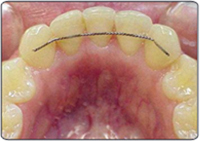|
 Orthodontic treatment involves moving your teeth, either by
tipping or rotation, into a new position. Pressure applied
to your teeth leads to a biologic process that allows the
bone that housed the roots of the teeth to change dimension,
permitting the movement of teeth.
Orthodontic treatment involves moving your teeth, either by
tipping or rotation, into a new position. Pressure applied
to your teeth leads to a biologic process that allows the
bone that housed the roots of the teeth to change dimension,
permitting the movement of teeth.
Teeth are not fused to the surrounding bone. The roots are
surrounded by a “periodontal ligament”. When teeth
are moved, particularly rotated, the fibers of these ligaments
are stretched, and due to their elasticity, the tendency for
relapse exists. This tendency is particularly noticeable in
the short term.
To prevent the possibility of relapse, some form of retention
is necessary. Conventionally, “retainers” are
delivered after treatment. They are removable appliances,
generally worn for an indefinite period. Since they are removable,
oral hygiene is easy. However, after an extended, or in many
cases even relatively short time period, teeth will often
revert back to their original position.
For patients who are willing to accept the inevitable settling
of teeth into reasonable, though perhaps no perfect position
over time, retainers are often phased out, or remade after
periods of neglect. For patients who are not willing to tolerate
more than minimal change after a beautiful result, either
day and nightly wear of retainers is called for, indefinitely,
or the placement of a bonded retainer is recommended.
A bonded retainer is a small wire bonded to the back of
the six front teeth. It cannot be seen, and is easy, with
a little effort, to floss beneath. They need to be checked
by the dentist or orthodontist periodically to ensure stability
and gum health beneath. Bonded retainers are becoming more
and more common, as sometimes there may be poor compliance
of old patients, particularly teens, in wearing removable
retainers. The bonded retainers can stay on for many years,
and often there is no reason to intentionally remove them
if they are kept hygienic.
|


 Orthodontic treatment involves moving your teeth, either by
tipping or rotation, into a new position. Pressure applied
to your teeth leads to a biologic process that allows the
bone that housed the roots of the teeth to change dimension,
permitting the movement of teeth.
Orthodontic treatment involves moving your teeth, either by
tipping or rotation, into a new position. Pressure applied
to your teeth leads to a biologic process that allows the
bone that housed the roots of the teeth to change dimension,
permitting the movement of teeth.